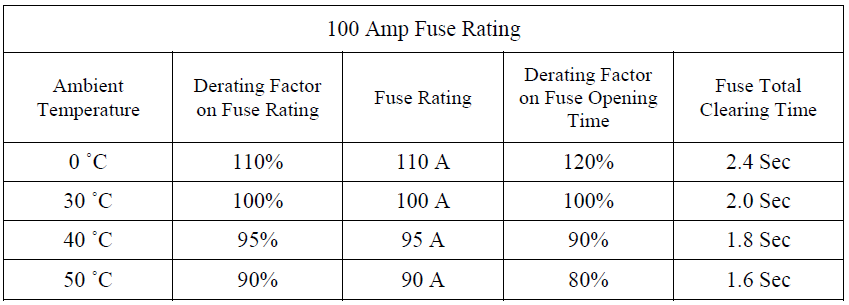Overcurrent Protection Devices | Electrical System Design
Overcurrent Protection Devices
Operation of electrical equipment above rated current produces excessive heat and will result in damage to the equipment. The basic function of overcurrent protection devices is to deenergize or disconnect from the supply, that faulty portion of the electrical distribution system before any damage occurs.
The overcurrent can occur as overload or short circuit.
Overload is a situation in which a particular device such as a motor draws more than rated current for an extended period of time. Another example is a branch circuit supplying multi-purpose receptacles and lighting outlets in which the total connected load exceeds the rating of the branch circuit conductors. These overloads produce an overcurrent that exceeds the rating of the circuit conductors supplying the load. Overloads generally result in a circuit level exceeding the rated level for a long period of time.
Short Circuit is the direct result of an ungrounded or hot conductor coming in contact with either another ungrounded conductor, the ground conductor, or the equipment grounding conductor.
In addition to the extreme heat generated by the short circuit current, short circuit current produces large mechanical forces between conductors and busbars due to the high levels of magnetic flux produced. The amount of force produced is proportional to the current squared. Thus, a current equals to 30 times rated will produce a mechanical force equal to 900 times rated! If the high magnitude of the current persists for a longer period of time, the electrical equipment may be destroyed.
Fuse Characteristics:
Generally there are two major classifications of fuses available: non-time delay and time delay fuses.
Non-Time Delay Fuse is a fast acting fuse that has no time delay intentionally built in.
This does not mean that the current interruption takes place instantaneously in a non-time delay fuse. It simply means that the design of the fuse does not intentionally introduce any additional time delay beyond what is normally required for the fuse to operate.
Time Delay Fuse Does have an intentional time delay built in so that it will operate for momentary overloads. The time delay feature is usually accomplished by incorporating a separate overload
section in the fuse.
The fuse time-current characteristics curves are plotted assuming a certain ambient temperature. For fuse application in ambient temperature other than the reference, a derating curve must be used. These curves are generally available from the manufacturer. A typical fuse derating characteristic is shown below. Note that there are two curves on the derating characteristic, one curve shows the effect of ambient temperature on the fuse rating, while the second curve shows the effect of ambient temperature on the fuse opening time. Note that both curves have an inverse relationship, in that both the fuse rating and opening time are decreased as the ambient temperature increases.
The following is an example shows 100Amp fuse derates in rating and opening time in conjunction with the ambient temperature.
Standard Fuse Derating Curves Fuse
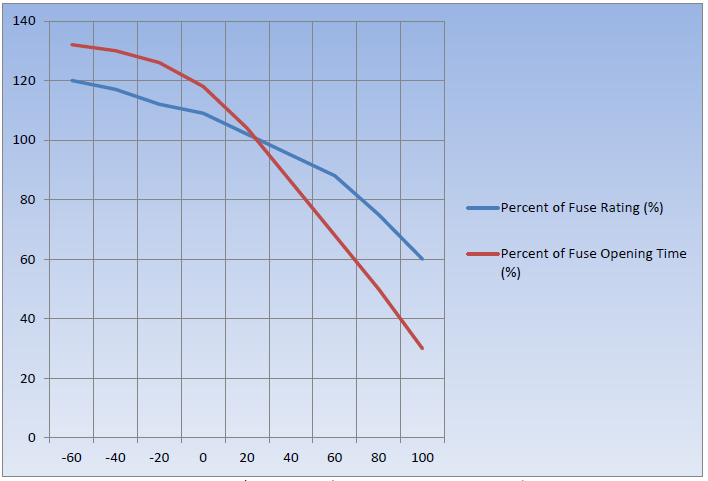
Peak Let Through Characteristic:
The ability of a current limiting fuse to limit the peak magnitude of short circuit current can be understood by examining the waveform of the short circuit current that flows through the fuse. A typical short circuit current waveform is shown below. The short circuit is assumed to occur at t = 0 in the figure. Note that this waveform has the appearance of a sinusoidal waveform but is displaced or offset from the x-axis due to the presence of inductance in the circuit. The amount of the offset in this waveform is a function of the ratio of inductive reactance to resistance in the circuit. This ratio is referred to as the X/R ratio of the circuit. A higher X/R ratio results in a large offset and a corresponding high value of maximum instantaneous current.
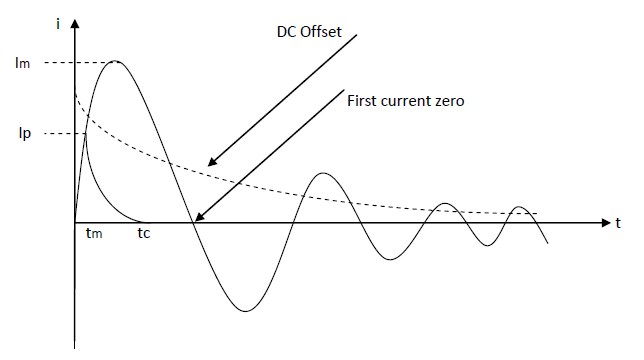
The maximum instantaneous current that would flow if there were no current interruption is
designated as Im. The maximum instantaneous current can be determined by multiplying the rms symmetrical short circuit current by a multiplier. This multiplier is referred to as the asymmetrical factor and is a function of the X/R ratio of the system. The asymmetrical factor becomes larger as the X/R ratio increases. The calculation of short circuit current will be detailed in a later chapter.
If a no current limiting fuse were employed in this circuit, the fuse would likely interrupt the current at the first current zero, as shown. This would allow the full available short circuit current to flow during the first half cycle of the waveform. Thus, the peak short circuit current would be equal to the maximum instantaneous current Im as shown. This high level of peak short circuit current may be high enough to cause significant damage to electrical equipment.
For sufficiently high levels of short circuit currents, application of a current limiting fuse would force the current to zero before the first current zero, usually within a half cycle. The total clearing time and melting time of the fuse are designated as tc and tm respectively. This limitation of short circuit current also causes the maximum instantaneous peak current to be limited to the value designated as Ip in the above figure. This value of current is referred to as the peak let through of the fuse.
Bear in mind, however, that the current limiting effect of a current limiting fuse will occur only for high level of current. The current level at which current limitation begins is referred to as the threshold current of the fuse. Current limiting will not occur at current levels below the threshold current level. Below the threshold current level, the maximum instantaneous current that flows will be equal to the rms symmetrical short circuit current multiplied by the asymmetrical factor.
At current levels above he threshold level, current limiting takes place, and the peak let through current can be obtained from the let through curve of the fuse. A typical let through curve for a current limiting fuse is shown below. The line designated as A-B in the figure represents a constant asymmetrical factor for a given circuit X/R ratio. Typically A-B line is plotted for an asymmetrical factor of 2.3, corresponding to an X/R ratio of 6.6. the instantaneous peak let through current without current limiting can be obtained by entering the graph at the level of prospective rms symmetrical short circuit current and projecting upward to line A-B.
The value of peak current is determined by projecting horizontally over to the vertical axis. The threshold current level occurs at the intersection of line A-B and the current limitation portion of the curve. The instantaneous peak let through current with current limiting is obtained by projecting upward to the current limiting portion of the curve.
It can be seen from the peak let through curve that current limitation occurs only at short
circuit current levels exceeding the threshold level.
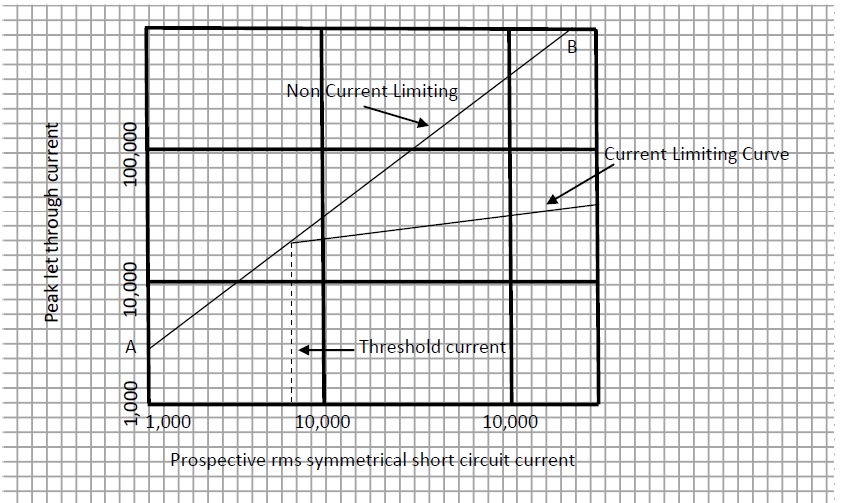
Example: Using the peak let through curve shown above, determine the peak let through current with and without current limiting effects for the following rms Peak symmetrical short circuit current levels. (a) 3,000A, (b) 10,000A, (c) 100,000A.
Solution:
(a) Current below the threshold level, thus no current limiting taking place, Ip = 5,000.
(b) With current limiting, Ip = 20,500A, without current limiting, Ip = 28,000A.
(c) With current limiting, Ip = 34,000A, without current limiting, Ip = 280,000A.
All above current readings shown above are taken from scaled diagram similar to that shown above.
Circuit Breaker Characteristics:
Circuit breakers have three positions: ON position (contact close) allowing load current to
flow through the breaker, OFF (contact open) the breaker is de-energized, and TRIPPED
position occurs when breaker contacts have opened due to the operation of the breaker trip
mechanism resulting from an overload or short circuit or by the operation of the shunt trip or
undervoltage trip coil if so equipped.
Trip Mechanisms
Thermal Circuit Breaker Trip Mechanism:
The basic operation of the thermal trip mechanism is shown below.
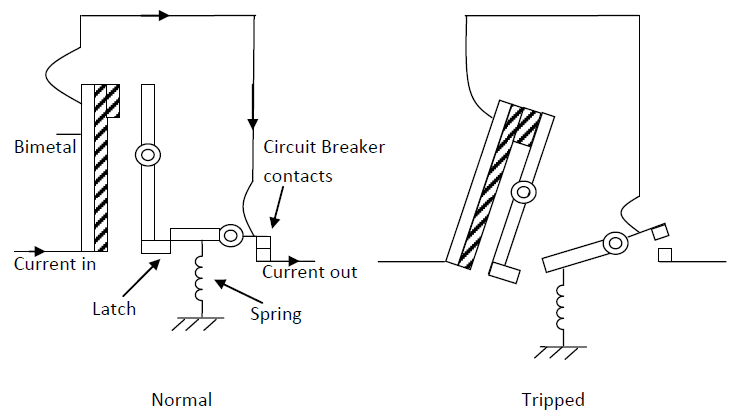
With the breaker contacts closed, load current flows through the breaker, causing heating of the bimetallic element. Heating of the bimetal causes the bimetal strip to bend to the right due to the difference in co-efficient of thermal expansion between the two metals making up the element. For current flow within rated conditions, the heating effect is not sufficient to cause the bimetal to move any significant amount. Resetting of the trip mechanism is accomplished by manually moving the breaker handle to the OFF, then ON position, this will reset the latch and spring mechanisms, provided the bimetal element has returned to its normal position. The thermal element typically responds to overload conditions from 1 to 10 times the breaker rating.
Magnetic Circuit Breaker Trip Mechanism:
The basic operation of the magnetic trip mechanism is shown below.

This mechanism responds only to high currents levels, typically 5 to 10 times the breaker rating. With the breaker contacts closed, load current flows through the electromagnetic coil in the trip mechanism. When the pick-up current level is reached, the armature is pulled into the electromagnet, thereby releasing the latch mechanism. The breaker contacts are then forced open due to the spring force. As with the thermal trip, resetting is accomplished by moving the breaker handle to the OFF, then ON position.
Since magnetic breaker is best responding to high current (short circuit), and thermal breaker
is best for low currents (overload), a combination breaker was developed and referred to as
thermal-magnetic breaker.
Magnetic Circuit Breaker Trip Mechanism:
The electronic trip mechanism employs the use of a current sensing device located in the breaker housing. This sensor monitors the current waveform and supplies a solid state digital trip system. The trip system computes the rms equivalent of the current waveform to determine if tripping of the breaker is required. Generally there are no thermal or magnetic trip mechanisms in this type of breakers. Thermal and magnetic characteristics are modelled by the electronic trip system to achieve desired results. The ampere rating of the breaker is typically established by use of a rating plug inserted into the front of the breaker housing.
Adjustable parameters often include the instantaneous trip current level, long time delay, and short time delays.
